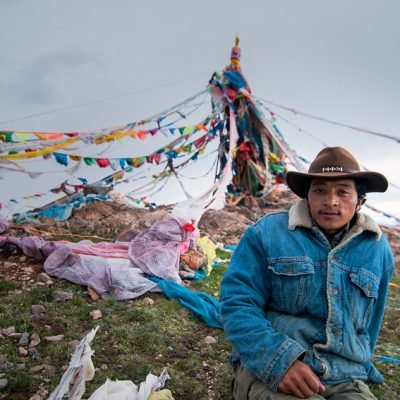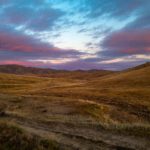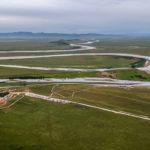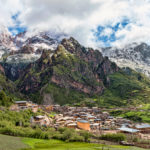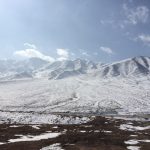Ecotourism and Sustainable Development
I have lived in the mountains of western China and Central Asia for 10 years now and I am constantly looking for new ways to invest in local communities through
Elevated Trips. As I travel to nomad areas I find myself wondering, what will become of the beautiful nomadic culture in 30 years when so many of these nomads have moved into large cities. Already as of 2020, almost half of traditional nomads in Tibet have traded in their yaks and yak dung stoves for modern amenities in high rise apartments. More and more often I see Tibetan women shopping in ultra-urban grocery stores and shiny malls for things they may once have never had heard or would have produced by their own hands while living in a yak hair tent just 10 years ago. During this transition there is a much greater level of education, literacy, and access to health care and the benefits are undeniable.
But in the transition from rural producers to urban consumers there are so many questions. Will people forget how to weave rope from yak wool? Who will steward the land they once lived on? What will happen to the unique wildlife like the Snow Leopard or the Tibetan Antelope or the Tibetan Fox that roam these mountains? What will happen to their identity as a simple people of the mountains who now find themselves riding metros and using the internet? With shifting technology and cultures changing faster than they ever have in history, the traveler is left to question, what role do I have in this transition? How do I access and experience something traditional, simple, natural – like the old ways of the nomads – in the face of modernization and globalization?
Tourism, like most tools, can be used for good or evil and as more people travel around the world we are asking ourselves, “What does it mean to be traveler who leaves positive changes and impressions behind us?” These changes are not just about leaving a cleaner, greener environment. They also mean living in a place with a richer cultural environment.
The question that many of us want to answer is this:
How do we use tourism not just for a week of fun but also for conservation and development in the local area?
Definition of Ecotourism
Ecotourism is now defined by the International Ecotourism Society as “responsible travel to natural areas that conserves the environment, sustains the well-being of the local people, and involves interpretation and education”
If tourism is rightly managed it can be win/win. Rather than being a one way street where travelers move in an environment for a few short days, take selfies, and leave the environment the same or worse than before their arrival, ecotourism aims to help both the traveler and the community in a long term sense.
In order to achieve this win/win outcome we have to think about what the intended results of ecotourism are and then work backwards to see how we can manifest those in the reality of travel. The definition above given by the International Ecotourism Society gives us a good starting point.
Ecotourism should do 3 main things in a community:
1.) Bring direct benefit to local people and communities
Benefits should not all go to large travel companies and online travel agents. Although these are often the first things we find on a Google search, most of these large companies have very little to do with the change that happens at a grassroots level. To see communities changed, that must come from within and change must be affected at the ground level. So when you travel try to make sure as much as your money and time is going to locally owned and operated small businesses that hire local guides, use local drivers, and locally owned boutique hotels and home stays.
2.) It should go beyond “doing no harm”- it should contribute actively to conservation outcomes
Sustainable travel has become a popular idea in 2020. Although this is a good thing, the word “sustainable” suggests that we leave a place roughly in the same condition as we found it. If we find a lake with no trash, we should take away the trash we packed in. While this is a minimum standard for healthy, responsible travel, cleaning up trash is not enough to actively promote conservation of the land.
For example, there are helpful trends in travel where travelers are not using using plastic bottles, plastic straws, or plastic bags to reduce trash and pollution. While these efforts are a great start, there is more to the wider picture of conservation. This is responsible tourism – but does not help locals in and of itself. There should be real actions and initiatives as a result of community empowerment and awareness that arise from the tourism. People should be made aware of the environmental problems facing a specific species and the locals guiding them in such a situation. And, more importantly, there should be some real change or project that arises from the education. A hot spring, once overused and full of litter, should be cleaned and kept clean and restored as a natural and beneficial part of the ecology . The habitats of animals should remain respected and we should see populations flourishing and coming back to life. Grasslands that were once trampled from too much tourist activity should come back to life and we should see a replenishment of the streams and biological communities around them.
3.) Includes Education
Education should both be outward (to travelers) and inward (to the community who walks in and inhabits the natural resource). Education should both increase capacity and awareness and environmental awareness. This is where development really happens.
When we talk about ecotourism the focus is often on conserving the environment. That is what the “Eco” part of ecotourism comes from. That is certainly one of the outcomes we want to see but it is really only 30% of the equation. Communities should always be the focus of ecotourism. These are the men and women and families who live on the front lines and it is they who should benefit in long term and then be responsible for conserving the land they live on. This means that ecotourism does not just affect a few guides who have some investment in protecting natural resources. It means that entire communities and villages are getting educated and buying into the process.
In summary, ecotourism is defined with three main components
1.) Community Development
2.) Conservation
3.) Education
If we used these 3 criterion to validate those operating in the industry, we have to admit that most tourist companies who claim be ecotourism venues are not in reality doing all of these 3 things and doing them well.
Experience and Advice For Moving Forward
In my 10 years living on the Tibetan Plateau, I have worked in the following areas:
-Community health
-Income generation with ecotourism
-Disaster relief
-Conservation ( this actually affects all the other above areas)
If I have witnessed any success in these areas, I can say that the common element of success would be this:
Strengthening partnerships
Successful ecotourism (and any community development project) is one that is organized, lead, managed, and executed by the local people. Guys in suits in American or European offices don’t have the know-how or resources to manage the things on the ground. To do this, it means gathering people in local communities and letting them network and work out their own systems in a way that is cultural meaningful to them, even it it is out the box of our western ideas. Locals should be empowered to make decisions and manage their own partnerships.
The ecology of an environment depends on every species working together in a “web of life”. Where one species fails or declines, you see deleterious effects in the whole system. In the same way, ecotourism should not just point to one guy. It should not be about one guide or one community organizer who is trying to push forward his individual ideas. It should be a group of people who all have separate but equally important roles working together for common development.
Take this example that plays out in Central Asian mountain communities. There is a certain community in the mountains who has several interested parties in developing an ecotourism initiative. Here are some of the partners and individuals who are making up the larger picture:
–Advertiser/Promoter
There should be someone among them who speaks English and can help promote his homeland and recruit travelers to come visit his home. He will be the main and first point of contact that takes on guest bookings and will communicate clearly about the duration of the journey and what travelers are to expect as far conditions, prices, education, etc. He is the billboard to the outside world inviting travelers into his own little slice of paradise.
-Home stay hosts
There should be families who are willing to host guests in their home. And they should know the living standards visitors are looking for and be able to replicate those standards for a unique, clean, well prepared, authentic experience every time. Generally a home stay host will provide a dinner on Day 1, a breakfast on Day 2, and a clean, comfortable night of sleep.
-Horse trek guide
This is a member of the community who usually has 4-8 horses (who are well trained and docile and not too wild ) and is willing to train his horses and then rent them out to inexperienced riders for an afternoon or an overnight horse trekking experience. He serves as a guide for the travelers and helps his horses stay healthy and calm for the duration of the journey so that they serve the guests well.
-Guide
This is the guide that will stay with your tour group for the entire duration of their travel. This person would usually be the one that makes all the bookings and connects the traveling group with the horse trekking guide, the home stay hosts, the local experts, and brings the whole tour together in one cohesive theme or schedule. He or she will be the main contact for the guests to make sure they feel safe, informed, engaged, and well cared for during the journey.
-Driver
Rather than hiring a driver from a large travel agency, look what resources you have in your own community to provide appropriate and reliable transportation.
-Local Educator/Expert
This is someone in the local community who is an expert in their field. Perhaps in a monastery it is a Buddhist monk who is excellent at speaking about the history and ideas behind his monastic field. Or it could be a shepherd who happens to know a lot about the birds or wildlife of the area. These people can intersect with the travelers and give interviews or specific presentations on their area of expertise.
-Logistics Support
A camping expedition or a journey into the mountains may require extensive planning as far a meals, gear, or supplies. Some of the members of the community can be in charge of arranging these details and can find full or part time jobs in providing these services.
-Village Elders or Chiefs
The whole experience must be supported by the actions, wisdom, and authority of local governing powers. While these men or women may or may not have a direct hand in the ecotourism initiative they have important voices and their buy in and support is critical to the success of a program, as well as the partnerships that occur on a local level.
There are probably more available roles in a community than this. But this gives you an idea of how one community can work together to provide an excellent and all-inclusive experience to their guests. It really is about bringing the individual pieces of a puzzle together to create a larger picture. If the above example worked and everyone worked together to provide their own slice of the pie, you would have at least 10-12 people employed just in this one example. But for all that to work – it does not happen overnight. That takes time and leadership and effort to strengthen the partnerships. And that is one of the goals of ecotourism: to employ as many locals as possible to do what they are already proud of in a place they already know well.
As we have worked with nomadic communities across central Asia, we have also learned these important lessons that are integral to success:
Value Chains
Push the value down the chain!
Do not just keep the value (and the money) at the top but at the bottom of the chain.
Rather than having a big city car company make all the money, how could we get that same money into the hands of local drivers?
How do you transfer the money to the bottom of the pyramid – to the locals and not just the big rental car company? The more the value is pushed down the chain, the more locals are impacted and given meaningful employment.
Ecotourism, when rightly practiced, represents a traditional pyramid where the majority of value and income sits wide at the bottom (at the grassroots level) in local communities and the top of the pyramid (the middle men and travel agents and big booking sites) is thin. Of course, we know that in reality most of the money spent on tourism in today’s market looks exactly opposite to this, producing a top-heavy inverted pyramid with a wide upper “roof” and a narrow local “base”. Ecotourism tries to flip this inverted pyramid so the money and the power is in the right hands of people with their boots on the ground.
Listening to Mountain Voices
As foreigners we have a tendency to come in to new countries with a bunch of NGO’s or programs and tell the people what they need because we have been to university and have a degree in these matters. This tends to result in a bunch of eager locals who want to get the free hand outs passed out by the visiting (and well-intended) foreigners. Sometimes, there are a few locals who are really passionate and interested in our programs or development for their communities, but these people are hard to sort out from those who are just looking for the next free ride and cheap thrill on the most recent “foreign circus in town”. Some locals even travel from one NGO to the next, just waiting for the next wave of foreign support and money.
One way we can combat this “toxic charity” is to spend more time listening to locals. Rather than coming in as experts, we as foreigners come in first as listeners and learners. Listen to what communities are already doing and come alongside that, rather than trying to force your personal program or agenda into a culture that may or may not really understand or want it.
Don’t force your foreign campaign on locals saying “Do this! Do that!”. Come to understand what they already are doing, where they already want to go, then come under that (not over it!). Let the locals lead you, rather than you leading the locals. Come in humbly as a learner and a servant, rather than a leader and commander. You should just be the spark that ignites a pile of wood that is already there.
Understand The Context
You have to understand the cultural and environmental context of where you are working. The value of ecotourism is that travelers are invited into an authentic culture that is unique from any other place they have been. It is not some foreign idea that happens in a vacuum or something that is imported or forced. The best ecotourism experiences are those that are authentic and feel like it is allowing the travelers a window in the soul and spirit of a community. See what the local people already have. And ask yourselves and them: What are they already doing that might be interesting to travelers?
In our case in western China, the social context of tourism in Qinghai is within the framework of nomads who migrate with their yaks and sheep on a monthly basis to find new pastures.
We must know the social context of nomads to understand how a tour would work in that culture and, in our case, that context looks and feels like this:
-Livestock farmers and domestic livestock
-Life on the edge – harsh life in a high altitude environment
-Mobility (nomadic rhythms based on the grazing and growth of grass)
-Rapid change- nomads have been leaving their pastures in large numbers to enter into more urban areas
-Urbanization
Recognizing these factors (both positive and negative) of the cultural modern context of the high plateau, helps us identify what are the opportunities and needs of local communities. Notice that we did not tell them what their need was. We listened to what was already happening on the ground level and built structures around that.
Part of seeing the cultural context means finding out what resources the locals have. Every community has something going for them and can tap into what they already have to attract guests. Communities that say “We have nothing to give to outsiders” have not looked close enough at their own native resources or are seeing a possible advantage as a disadvantage. Maybe they have medicinal plants that can be learned about and applied as traditional medicine. Perhaps they have a unique form of pottery or weaving or embroidery or calligraphy. There might a unique dialect or expression of folk religion or culinary process that is special to that area. Rather than trying to imitate western trends that make everyone dress and feel alike, identify local trends that set them apart and emphasize those.
A large part of the first steps of the ecotourism process is to gather locals and have them brainstorm on what resources they already possess. Things that were once seen as “backward” or “ancient” may, in fact, be the key component to their unique experience that can be provided to travelers. This provides identity and cultural dignity for communities who often see themselves as “lesser” than comparatively more westernized, modernized parts of society.
In our case in Qinghai Province, we recognized these particular resources and the need to build on those:
-Mountains
-Communities (festivals, activities, etc)
-Unique wildlife (birds, blue sheep, Tibetan antelope, Wild Ass, wolves, weasels, pikas, snow leopards)
-Rich grassland environment with rivers and grazing grass
Based on these available resources the locals created new opportunities that took advantage of their natural environment and allowed travelers to experience them in a new way.
Ecotourism identifies and leverages these natural assets (mountains) and cultural assets (people/customs) and then combines them into a unique experience. Communities started developing new activities in southern Qinghai Province as they gathered together including:
-Rafting and kayaking
-Horse riding
-Bird Watching
-Historical forms of pottery
Although most nomads could not swim and had never seen a whitewater raft, communities gathered together and purchased rafts and started taking professional rafting and CPR courses to be able to guide trips on the Yangzte and Mekong Rivers. These men and women learned to swim and learned to be raft guides on some of the most important rivers in Asia (and in community pools and gyms). Communities came together to provide the resources to support the infrastructure around these trips as villagers volunteered their homes and tents for homestays and culinary experiences along the river, and drivers were found who could transport both the rafts, materials, and the guests.
This is a classic example of the process of ecotourism. Communities gathered and self-organized with some positive (and not patriarchal) influence and training from westerners. These communities then identified their resources and created new opportunities and networks that helped not only one person or agency but several villages and regions that traditionally had few opportunities for self improvement. And now they are running and multiplying it themselves without too much outside western money or leadership.
Now there are professionally trained and certified raft guides who were once nomads with only a few yaks and sheep. As they have transitioned out of the livestock trade they have found meaningful employment where they get to stay on their native lands and protect these lands through educational and enriching experiences. In a world full of constant transition they are working very hard at adapting and have found positive channels of adaptation that help their families and communities through adventure travel.
While ecotourism is not always this successful (and does not necessarily have to learn new skills like rafting), this type of change can be the goal for our experiences as we navigate and empower communities to operate in self-provision and innate dignity and honor.
In this case the lesson learned is that tourism can come and help build cultural identity and environmental conservation, or it can destroy it.
I have to thank Dr. Marc Foggin for his thoughts on ecotourism and development. Much of the thoughts found above come from his own personal research and experience as a pioneer of ecotourism and community development in Central Asia. For more information by Dr. Marc Foggin, please look up this article in a journal called “Land”. This article shows conclusions and research in tourism in western China:
Lessons for China’s Belt and Road Initiative in the Mountains of Central Asia
